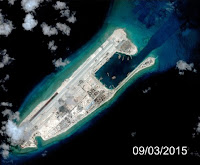Reefs, carbonate platforms created by the actions of benthic marine organisms, are considered to be among the most important and biodiverse marine environments, and in addition serve as important sinks of carbon dioxide and provide coastal regions with protection against ocean storms. Modern reefs are typically dominated by Corals, though the fossil record suggests that earlier in Earth's history the oceans may have been home to reefs made by a variety of other organisms, including Sponges, Bryozoans, Bivalves, Algae, Bacteria and possibly Brachiopods. In all cases reefs are presumed to be dominated by photosynthetic or filter feeding organisms, intolerant of high sediment loads, and therefore are not expected to form around the mouths of major river systems where extensive sediment is being carried into the sea.
In a paper published in the journal Science Advances on 22 April 2016, a team of scientists led by Rodrigo Moura of the Instituto de Biologia and the Instituto Alberto Luiz Coimbra de Pós-Graduação e Pesquisa de Engenharia the Universidade Federal do Rio de Janeiro, describe the discovery of an extensive reef system across the mouth of the River Amazon, a river that contributes about 20% of the total global freshwater input to the oceans, as well as carrying extensive sediments resulting in a rapidly growing delta system and extensive plumes of sediment-laden freshwater at surface levels, all conditions previously thought to make development of a reef system in the area impossible.
Despite being considered an unlikely location for a reef system, the Amazon is home to fisheries which target a number of Fish and Crustacean species otherwise considered to be reef endemics (i.e. species that only live on reefs, and the outer part of the delta system is known to be home to extensive oolith deposits - granular limestone beds only known to be produced as an erosional product of fragmented reef limestones.
Moura et al. carried out sampling of the seafloor beneath the Amazon sediment plume using dredges and sonar observations from several research vessels, as well as examining an extensive set of museum specimens and records of organisms collected from the Amazon River Delta area. From this data they deduce the existence of an extensive reef system covering at least 9500 km2 between Maranhão State, Brazil, and the border with French Guiana (they did not carry out surveys in French terretorial waters).
This Reef is home to a number of Corals, notably Black Corals and other species typically at home in deeper, darker waters (typical reef-building Corals are host to symbiotic Algae, Zooxanthellae, which are essential to their development, and which prevents them growing beneath anything which blocks light, such as the sediment plume from the Amazon River). However these are not thought to be responsible for the majority of reef construction, rather this appears to be the work of Coraline Red Alagae, Rhodoliths. Moura et al. also note the presence of extensive Sponge beds, which may contribute to the structure of the reefs.
Map of the Amazon shelf showing the benthic megahabitats and seasonal influence of the river plume. (A) Distribution of reef fisheries and oceanographic stations. Manuel Luis reefs are the northernmost emerging reefs in Brazil. (B to D) Main structural and functional traits of the reefs in the Northern (120 m), Central (55 m), and Southern Sectors (25 m), respectively. Plume POC δ13C = −22.9 ± 0.7, δ15N = 4.0 ± 1.2; Plume DOC δ13C = −27.7 ± 1.0, δ15N = 1.3 ± 0.3. Subplume POC δ13C = −24.2 ± 1.3, δ15N = 5.1 ± 1.7; Subplume DOC δ13C = −26.6 ± 1.7, δ15N = 0.1 ± 1.8. Benthic (sediment) δ13C = −26.2 ± 0.6, δ15N = 2.2 ± 0.5. The plume lines represent the outer edge of the plume during that season, according to satellite climatology. Moura et al. (2016).
Moura et al. record the presence of a wide range of Atlantic and Caribbean reef species within the ecosystem, including at least one clearly invasive species, a Pacific Brittle Star, indicating that the reef system is already being modifies by human activity. They also note that the area is home to a number of oil new oil drilling sites, some of which expected to begin production in the near future, and that it is far from clear what effect this will have on the reef system.
See also...
 Assessing the impact of land reclamation in the Spratly Islands. The Spratly Islands are a widely distributed archipelago of over 750
coral reefs, atolls and islands in the South China Sea. Ownership of the
islands is disputed between surrounding nations, with China, Taiwan,
Thailand, Vietnam, Malaysia, the Philippines and...
Assessing the impact of land reclamation in the Spratly Islands. The Spratly Islands are a widely distributed archipelago of over 750
coral reefs, atolls and islands in the South China Sea. Ownership of the
islands is disputed between surrounding nations, with China, Taiwan,
Thailand, Vietnam, Malaysia, the Philippines and... Analysing the distribution of shallow-water Black Corals in the Hawaiian Archipelago. Black Corals, Antipatharia, are
Anthozoan Hexacorallid Corals known from across the world’s oceans,
particularly in waters below the photic zone, waters shallower than about 50 m
where light levels are high and attached benthic communities are dominated...
Analysing the distribution of shallow-water Black Corals in the Hawaiian Archipelago. Black Corals, Antipatharia, are
Anthozoan Hexacorallid Corals known from across the world’s oceans,
particularly in waters below the photic zone, waters shallower than about 50 m
where light levels are high and attached benthic communities are dominated... Five dead and four missing following explosion on oil production vessel off coast of Brazil. Five workers are known to have died and another four are missing
following an explosion on an oil and...
Five dead and four missing following explosion on oil production vessel off coast of Brazil. Five workers are known to have died and another four are missing
following an explosion on an oil and...
Follow Sciency Thoughts on
Facebook.

